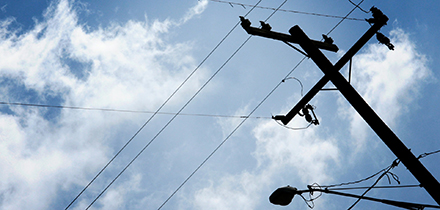The timber industry has stepped up its fight against the phase-out of wooden power poles across NSW, demanding proof that the manufactured ones won’t melt in bushfires. Source: AAP
The NSW branch of the Australian Forest Products Association has launched a new website urging people to sign a petition against Essential Energy’s shift to UV-coated fibreglass and resin poles.
The government-owned power infrastructure company, which services 95 per cent of NSW, says the change is necessary to boost its network’s resilience to events like the Black Summer fires.
During that disaster over the summer of 2019 and 2020, more than 104,000 customers were affected by power outages across the company’s network, and more than 3,200 power poles were damaged.
But the shift has upset some in the timber industry, which supplies the wooden poles that have long been used.
James Jooste is the NSW chief executive of the Australian Forest Products Association and has called on the government to direct Essential Energy to continue using hardwood poles.
He says there’s an absence of evidence to show composite poles are more fire resistant than wooden ones.
“Show us the proof.”
Mr Jooste says anxiety about adequate supplies of hardwood poles is justified, but only because government decisions are hampering the industry.
He points to the creation of protected koala hubs in the government’s proposed Great Koala National Park, which will cover native forests that are logged by the government-owned Forestry Corporation.
He says a review of the rules that govern native forest logging is also overdue, and that’s hampering the industry.
“It’s policy decisions that are impacting the supply of timber, not the availability of timber itself.”
But Essential Energy has hit back, saying it must act to reduce the impact of natural disasters on customers.
“The decision to use composite poles across one of Australia’s largest electricity distribution networks has been years in the making,” it has told AAP.
“We also consulted with our pole suppliers and Forestry Corporation of NSW across a range of topics including composite poles.”
The company has also released a photo to dispel concerns about the new poles melting.
The photo – taken by Essential Energy staff during the Black Summer fires – shows a manufactured, composite pole standing intact beside the charred remains of a timber one.
Its submission to the bushfires inquiry also pointed out that fibreglass cross arms that were already part of its network often survived undamaged, while timber poles were destroyed.
The Australian Energy Regulator also approved the switch to manufactured poles earlier this year, after a detailed examination.
Essential Energy says that was in part due to concerns about “insufficient quantities of timber poles suitable to meet the needs of Essential Energy over the 2024-29 regulatory period”.
The Forestry Corporation, whose hardwood division runs at a loss, has told AAP demand remains high for timber poles due to their affordability, durability, lower energy footprint and capacity to store carbon.
“By the time each pole has reached the end of service a new pole has grown to replace it.”
It has contracts to supply hardwood timber poles to other energy distributors until the end of 2028.
Essential Energy refuted suggestions the transition will be another economic blow for consumers during a cost-of-living crisis, saying the installation of more composite poles will cost an average residential customer less than $2 per year over the next five years.






